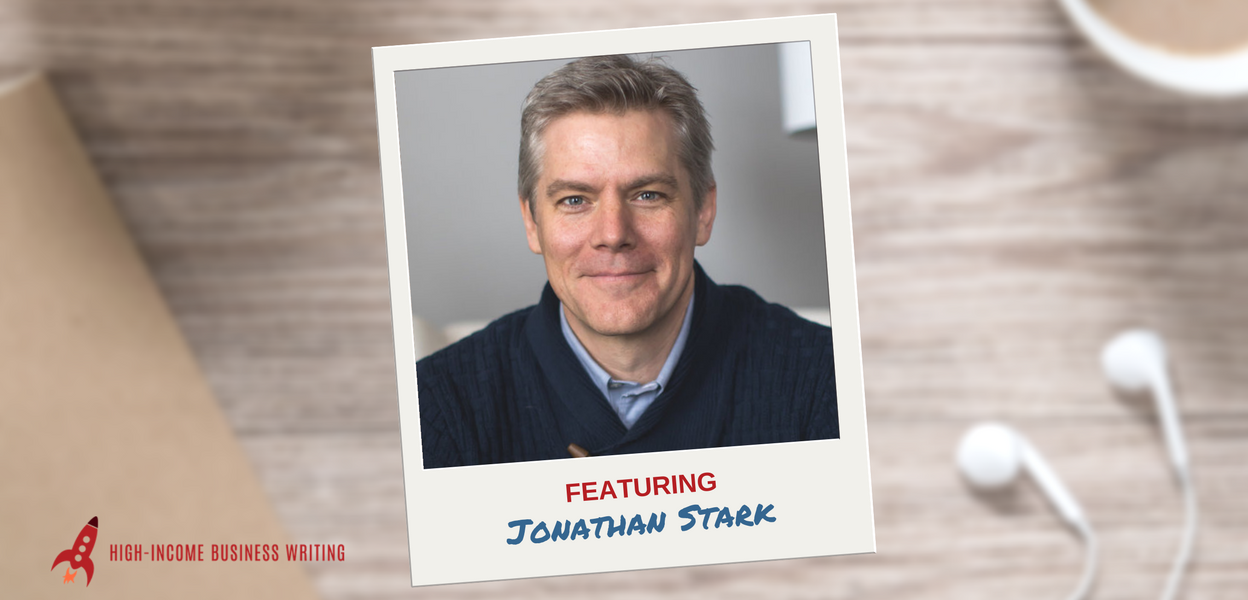There’s a growing interest among freelancers in the idea of “value pricing.”
I addressed this idea in my Smarter Freelancing podcast last year.
But while the concept of value pricing is interesting to many, it still feels like a theoretical, pie-in-the-sky idea to most creative professionals.
In this episode, we move from the theoretical to the practical. And we discuss three simple ways you can begin transitioning your business to this lucrative model.
My guest is Jonathan Stark, a mobile strategy consultant who helps retail brands thrive in a post-PC era. He’s written three books on web development including O’Reilly’s Building iPhone Apps with HTML, CSS, and JavaScript, which has been translated into seven languages.
He’s a real pro at value pricing, and I love the perspective he has on the subject. It’s straightforward and very applicable to what we do as freelance writers and copywriters.
The notes that follow are a very basic, unedited summary of the show. There’s a lot more detail in the audio version. You can listen to the show using the audio player below. Or you can subscribe in iTunes to get this show delivered straight to the Podcasts app on your smart phone, tablet or iPod.


High-Income Business Writing with Ed Gandia
#090: Three Simple Ways to Transition to a Value Pricing Model
Tell us about yourself
Jonathan is a business coach who got his start in mobile strategy consulting. While advising people on mobile strategy, he often found himself talking about value pricing. Eventually, he started coaching software developers on how to transition from hourly billing to value pricing.
What is value pricing?
Value pricing is a type of fixed bid. In value pricing, the price is based on the value of the project to the company.
How do you move into value pricing if you (and your clients) are accustomed to an hourly charge?
You don’t have to move into value pricing all at once. You can start by dabbling in it.
There are three ways to get started:
- Add a second, flat rate option to your proposals
- Break off the first phase of a project and price it as a fixed bid
- Offer a productized service on your website.
When you first try value pricing, you’re going to price yourself WAY too low. So start small.
Method #1: Add a second, flat rate option to your proposals
Follow your usual proposal process but include a flat rate price as a second option in your proposal. Set the flat rate at about 50 percent more than the hourly estimate you’ve worked out in your head. Emphasize that the flat rate price is a final price with a guaranteed outcome. Then see what happens.
With this approach, you’ve made any competing hourly bids seem risky to the client. They don’t know the final price of an hourly quote, so there’s inherent risk. In fixed bid, you assume that risk.
What if the scope isn’t fully defined yet? How can you quote?
Do your own diagnosis of how to achieve the desired outcome. Focus on the client’s end objective, not the scope. Base your quote on a rough estimate of how much money the client will make off the project, not an estimate of scope.
What if the client doesn’t believe you can deliver the goal?
The client has to trust you. Don’t work with clients who don’t. You have to pick your audience and become an expert in the eyes of that audience.
Method #2: Price the first phase of a project as a fixed bid
See if you can break off the first part of a project and price it separately. Depending on the size of project, this first phase could be fairly small.
Once you’ve completed the first phase, you’re set up nicely to complete remaining phases. You know the project and the client trusts you.
This approach works well for website copy or white paper projects. Use the first phase to figure out what information to include and how to map it out. Because they’re paying for it separately, clients will take the first phase of the project more seriously.
Method #3: Offer a productized service on your website
Take a well-defined, fixed-scope piece of work and set a price for it (such as a white paper). Then put it on your website.
Clients will start to self-select based on your pricing. You’ll avoid low value customers and attract high value customers.
Be careful not to talk about deliverables. You don’t want to get into arbitrary measurements, like number of pages. Keep your focus on doing what’s best for your customer.
What’s our goal with these three approaches?
Your goal is to deliver a high-value outcome to your customer for which you are well compensated. Over time, you’ll gravitate to work you can deliver quickly and has the biggest impact for clients.
Value pricing is a way off the hamster wheel of working more hours and raising rates.
When you charge a fixed bid that’s based on value, you can require 100 percent payment up front.
About 80 percent of Jonathan’s clients will pay the full amount up front. Some will ask for 50 percent up front and 50 percent on completion. But Jonathan won’t accept payment on completion because most projects have no firm end date. Instead, he will pick a day for the second payment (e.g. 45 days from start date).
How many pricing options do you give clients?
Jonathan gives clients three options on the project proposal. All are final price.
Option one is what was discussed with the client. This demonstrates that you were listening to the client.
Option two is usually option one with some added items.
If Jonathan thinks option two is the best option for the client, he’ll price it in a way that encourages the client to choose it.
Where can listeners learn more about you?
Jonathan’s coaching website: expensiveproblem.com
Jonathan’s recommended reading list.






